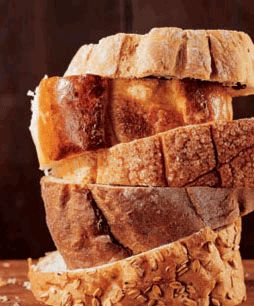
Top 10 questions about cereal bread
Grain bread is more and more popular with people because of its unique nutritional value. However, in the face of many varieties of flowers, how to make wise choices, let us first understand them.
When it comes to snacks, many people will think of potato chips, plums, melon seeds, etc. In fact, taking cereal bread as a snack is a good choice, not only to relieve boredom but also to supplement nutrition. Grain bread is richer in nutrition than its refined counterparts (such as white bread). Because of its unique plant germ, cellulose-rich bran, these brans provide vitamin B; minerals zinc, magnesium, and chromium; vitamin E and selenium with antioxidant effects; and biologically active plant compounds, If there is anti-cancer lignin, saponins that are good for the heart and oligosaccharides that are good for the intestines. Cereal bread can also prevent diabetes, because cereals will be slowly digested, can stabilize blood sugar and prevent the excessive secretion of insulin, in order to prevent the occurrence of diabetes.
How to identify cereal bread? It's very simple, you just need to pay attention to the product ingredients on the packaging paper will be clear at a glance. If the first item in the ingredients list is marked with a rich cereal it is a cereal bread. If the cereal components are ranked behind the date of production or sugar, it means that there are not many cereals in the food. In addition, each piece of bread should contain at least 2 grams of fiber. Another way is to use the bread in your hands. If you feel that the bread is dense and compact, there is a distinct grain of cereal, which is grain bread.
In order to help you to buy the most nutritious and most suitable cereals for you, we specially arranged Q&A to teach you to be a smart bread buyer.
Question about cereal bread
Q: I often hear people say that white bread has no nutrition, is that true?
A: Although fiber and trace minerals have been removed during the finishing process, white bread is not without merit. It is rich in iron, vitamin B and folic acid. However, white bread contains artificially added cellulose, and two slices of white bread may contain about 5 grams of such cellulose, which exceeds the natural content of cereal bread and is not good for the body.
White bread health index: ★
Q: Is wheat bread a brown white bread?
A: It's not right. The flour for making wheat bread contains 25% cereal flour and 0.5 to 1 gram of fiber per slice. Antioxidants and plant compounds in white bread have been removed during the finishing process but contain enhanced nutrients.
Wheat Bread Health Index: ★
Q: The more yeast in the bread, the better?
A: No. Yeast is used in baking machines to make bread, not the nutrients contained in cereals. Enjoy your delicious, careful not to have too much yeast.
Q: Does rye bread really fight cancer?
A: Whole grain rye contains lignin components that convert to enterolipids, an estrogen-like molecule, in the body that can reduce the incidence of breast cancer. There are also coriander seeds containing lemon olein and a small amount of perillyl alcohol, which also has anti-cancer effects. Pay attention to the ingredients on the package when buying.
Rye Bread Health Index: ★★
Q: Why is the color of rye bread so deep?
A: Because there is molasses or caramel in the bread, the other ingredients are fine flour. The real rye bread crumb contains grain components, each slice containing 1 to 2 grams of fiber and whole grain rye. Rye bread, whole grain rye wholemeal bread can be bought at the grocery store or bakery.